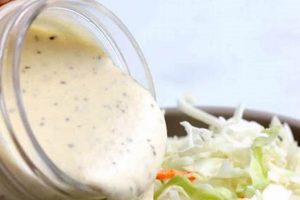The formulation describes the methodology for creating a dairy-free alternative to traditional condensed milk. This involves combining plant-based milk, such as coconut, soy, or oat milk, with a sweetener, like sugar or maple syrup, and then reducing the mixture through simmering to achieve a thickened, concentrated consistency. The resulting product replicates the sweet and creamy texture of its dairy counterpart.
This approach provides options for individuals with dietary restrictions, ethical beliefs, or health concerns related to dairy consumption. It allows for the enjoyment of recipes that traditionally require the ingredient, expanding culinary possibilities within plant-based diets. Furthermore, the historical context reveals a growing demand for such alternatives, driven by increasing awareness of veganism and lactose intolerance.
The article will now delve into various methods for producing this substitute, exploring different plant-based milk options, sweetener variations, and techniques for achieving optimal thickness and flavor. Considerations for storage and shelf life will also be addressed, providing a complete guide to its preparation and use.
Preparation Guidance
The following advice outlines crucial considerations for successful execution when crafting a dairy-free condensed milk alternative. Attention to these details will yield a product closely mirroring the texture and sweetness of traditional condensed milk.
Tip 1: Plant-Based Milk Selection: Coconut milk, particularly full-fat varieties, provides the richest consistency and closest approximation to the dairy product. Soy or oat milk yield thinner results but offer neutral flavor profiles suitable for versatile applications.
Tip 2: Sweetener Calibration: Granulated sugar produces a clean sweetness. Maple syrup or agave nectar impart distinct flavors, altering the final product’s taste profile. Adjust quantities based on desired sweetness and the chosen milk’s inherent sugar content.
Tip 3: Controlled Simmering: Maintaining a low, consistent simmer prevents scorching and ensures even evaporation. Frequent stirring is crucial to avoid sticking and promote a smooth texture. Monitor closely during the final stages of reduction.
Tip 4: Starch Addition (Optional): Incorporating a small amount of cornstarch or tapioca starch thickens the mixture without significantly impacting flavor. This is particularly beneficial when using lower-fat plant-based milks.
Tip 5: Texture Assessment: The mixture will thicken further upon cooling. Stop simmering when the consistency resembles a slightly thinner version of traditional condensed milk, accounting for this post-cooling effect.
Tip 6: Cooling Procedure: Allow the finished product to cool completely before transferring it to an airtight container. Refrigeration is necessary to maintain freshness and prolong shelf life.
Tip 7: Adjustment After Cooling: If the cooled product is too thick, a small amount of additional plant-based milk can be whisked in to achieve the desired consistency. Conversely, if it’s too thin, gently re-simmer for a short duration.
Adherence to these guidelines ensures a high-quality, dairy-free condensed milk substitute, suitable for various culinary applications. Careful monitoring and precise execution are essential for optimal results.
The subsequent section will address potential troubleshooting scenarios and provide additional insights into optimizing the final product’s flavor and texture.
1. Milk Selection
Milk selection is a foundational component in the formulation of a plant-based condensed milk alternative, directly influencing the final product’s texture, flavor profile, and overall suitability for specific culinary applications. The inherent characteristics of the chosen plant-based milk, such as fat content, protein composition, and natural sweetness, dictate the reduction process’s effectiveness and the need for supplementary adjustments. For instance, coconut milk, owing to its high fat content, yields a richer, creamier result, closely mimicking the texture of traditional dairy-based condensed milk. In contrast, almond or rice milk, with their lower fat content, require supplementary thickeners or extended reduction times to achieve a comparable consistency. The selection thus operates as a primary determinant of the recipe’s success.
The impact of milk selection extends beyond textural considerations to encompass flavor nuances. Coconut milk imparts a distinct coconut flavor, which may be desirable in certain applications but limiting in others requiring a neutral taste. Soy or oat milk, characterized by their relatively mild flavor profiles, offer greater versatility in recipes where the condensed milk alternative serves primarily as a binder or sweetener. Furthermore, the protein content of the chosen milk influences its behavior during simmering; higher protein content can lead to curdling if not properly controlled, necessitating careful temperature management and stirring techniques. The practical significance of this understanding lies in the ability to tailor the milk selection to the specific requirements of the target recipe, ensuring optimal flavor and texture integration.
In summary, milk selection functions as a critical control parameter in the production of plant-based condensed milk. Its strategic manipulation allows for the achievement of diverse textural and flavor profiles, adapting the alternative to a wide range of culinary contexts. A thorough understanding of each milk type’s characteristics is essential for mitigating potential challenges, such as insufficient thickening or undesirable flavor contributions, and maximizing the overall quality and usability of the final product. The connection is therefore causative and significant, forming the cornerstone of a successful plant-based adaptation.
2. Sweetener Type
The choice of sweetener is pivotal in crafting a satisfactory dairy-free condensed milk alternative. It impacts not only the finished product’s sweetness level, but also its color, viscosity, and overall flavor complexity, interacting synergistically with the base plant milk to define the final result.
- Granulated Sugar
Granulated sugar provides a consistent, neutral sweetness, allowing the flavor of the chosen plant milk to remain dominant. Its reliable crystallization properties facilitate a smooth reduction process, contributing to a stable final texture. Example: a recipe using oat milk benefits from granulated sugar’s clean taste. The implications include predictable sweetness and a lighter color profile.
- Maple Syrup
Maple syrup introduces a distinctive, complex sweetness with caramel and woody undertones. It darkens the resulting condensed milk and may slightly alter its viscosity due to its inherent moisture content. Example: using maple syrup with coconut milk creates a richly flavored, darker-hued alternative. The implications are a more pronounced flavor and potentially altered texture necessitating adjustments during reduction.
- Agave Nectar
Agave nectar offers a high level of sweetness with a relatively neutral flavor profile, though some detect a subtle metallic note. Its high fructose content can accelerate the reduction process but may also contribute to a stickier final texture. Example: agave used with almond milk produces a very sweet, pale-colored condensed milk alternative. Implications include heightened sweetness and a need for careful monitoring to prevent over-thickening.
- Brown Sugar
Brown sugar, due to its molasses content, imparts a deeper caramel flavor and a richer color than granulated sugar. It also introduces additional moisture, requiring adjustments to the reduction time to achieve the desired consistency. Example: combining brown sugar with soy milk yields a deeply flavored, almost butterscotch-like result. Implications are a richer flavor, darker color, and potential need for extended simmering.
The selection of sweetener, therefore, is far from arbitrary; it represents a deliberate choice influencing the organoleptic properties of the plant-based condensed milk alternative. Understanding the impact of each sweetener allows for precise control over the final product, enabling the creation of a dairy-free substitute that aligns with specific culinary needs and flavor preferences. Different ratios are also use depend on user preferences.
3. Simmering Control
Simmering control is a critical factor in the successful preparation of a dairy-free condensed milk alternative. The process of controlled simmering directly affects the texture, color, and overall stability of the final product. Inadequate temperature regulation or inconsistent heating can result in scorching, uneven reduction, or undesirable flavor alterations, thereby compromising the quality of the substitute.
- Temperature Regulation
Maintaining a consistent, low simmer is essential to prevent burning and promote even evaporation. Excessive heat can lead to caramelization and an off-flavor, while insufficient heat will prolong the reduction process unnecessarily. Monitoring the temperature using a thermometer, if available, and adjusting the heat source accordingly is crucial for optimal results. For example, maintaining a temperature between 180-200F (82-93C) generally provides the optimal simmering range. Deviation from this can lead to undesirable outcomes.
- Stirring Frequency
Regular stirring prevents the mixture from sticking to the bottom of the pot and ensures even heat distribution throughout. Infrequent stirring can result in localized scorching, altering the flavor and color of the final product. Furthermore, consistent stirring promotes the incorporation of solids and prevents the formation of a skin on the surface, contributing to a smoother, more uniform texture. A recommended stirring interval is every 2-3 minutes, adjusting frequency based on the viscosity and behavior of the mixture.
- Evaporation Rate
The rate of evaporation directly impacts the final consistency and sweetness of the alternative. Too rapid evaporation can lead to a grainy texture and excessive sweetness, while too slow evaporation will prolong the cooking time and may result in an insufficiently thick product. Adjusting the heat and surface area of the simmering pot can influence the evaporation rate. Using a wider pot promotes faster evaporation, while reducing the heat slows the process. The aim is a gradual, controlled reduction in volume.
- Visual Cues and Texture Assessment
Relying solely on time is insufficient; visual cues and texture assessments are crucial for determining the endpoint. The mixture should gradually thicken and coat the back of a spoon. A slight color change also indicates progress. As the mixture cools, it will thicken further; therefore, it is essential to remove it from heat while still slightly thinner than the desired final consistency. This requires careful observation and tactile feedback to avoid over-thickening, which can result in a paste-like texture.
These facets of simmering control collectively determine the success of the dairy-free condensed milk recipe. Proper temperature maintenance, consistent stirring, mindful evaporation rate adjustment, and keen observational skills regarding visual cues and texture provide the means to achieve the desired consistency, sweetness, and overall quality of the substitute. Without diligent attention to these elements, the likelihood of achieving a satisfactory end product diminishes significantly.
4. Consistency Check
The consistency check represents a crucial control point within the process of preparing a dairy-free condensed milk alternative. Its implementation directly determines the final product’s suitability for its intended culinary application. The inherent absence of milk proteins in vegan formulations necessitates meticulous attention to achieving the correct viscosity through precise control of reduction and, if required, the incorporation of thickening agents. An inadequate consistency check can result in a product that is either too thin, lacking the characteristic richness of condensed milk, or too thick, rendering it unusable in recipes requiring a smooth, pourable component. For example, a plant-based condensed milk intended for a vegan key lime pie must possess a specific consistency to properly bind the filling and achieve the desired texture. Failure to accurately assess and adjust the consistency will inevitably lead to a compromised final dish.
Practical applications of the consistency check involve both visual assessment and tactile evaluation. Visual cues, such as the mixture’s ability to coat the back of a spoon or the formation of a “ribbon” when drizzled, provide indicators of sufficient thickness. Tactile assessment, performed after allowing a small sample to cool, confirms the final viscosity and allows for adjustments if necessary. Should the cooled mixture prove too thin, further reduction is required. Conversely, an excessively thick product can be tempered with additional plant-based milk to achieve the desired consistency. The iterative nature of this process underscores the critical role of the consistency check as an integral step in achieving a satisfactory outcome.
In summary, the consistency check is an indispensable element in the creation of a viable dairy-free condensed milk alternative. Its accurate execution directly dictates the product’s usability and its ability to replicate the functionality of traditional condensed milk in a variety of recipes. The challenges inherent in vegan formulations necessitate a proactive and discerning approach to viscosity assessment, ultimately ensuring the successful integration of the alternative into diverse culinary contexts. This process is vital in all vegan condensed milk recipe.
5. Storage Methods
Appropriate storage methods are paramount in maintaining the quality and extending the shelf life of a dairy-free condensed milk alternative. Unlike its dairy counterpart, plant-based versions may exhibit different spoilage characteristics, necessitating specific storage protocols to prevent degradation of texture, flavor, and overall usability. The efficacy of the vegan condensed milk recipe is directly tied to the ability to preserve the final product under optimized conditions.
- Airtight Containers
The use of airtight containers is fundamental in preventing oxidation and moisture absorption, two primary causes of spoilage in plant-based condensed milk. Exposure to air can lead to rancidity in the fats present in certain plant milks, such as coconut milk, while moisture absorption can promote the growth of mold and bacteria. Sealing the alternative in an airtight container minimizes these risks, preserving its flavor and texture. An example would be storing the prepared product in a glass jar with a tightly sealed lid, ensuring minimal air exposure. This directly impacts shelf life and flavor retention.
- Refrigeration Temperature
Maintaining a consistent refrigeration temperature is essential for inhibiting microbial growth and enzymatic activity that can degrade the quality of the vegan condensed milk. The optimal temperature range typically falls between 35-40F (2-4C). Fluctuations in temperature can accelerate spoilage and compromise the product’s safety. Regularly monitoring refrigerator temperature is advised to ensure adherence to the recommended range. Inconsistent refrigeration can lead to premature spoilage, rendering the condensed milk unusable.
- Freezing Considerations
While freezing can extend the shelf life of the alternative, it may also impact its texture. Upon thawing, some plant-based milks can exhibit separation or graininess. If freezing is necessary, portioning the condensed milk into smaller, airtight containers before freezing can minimize the impact on texture and prevent waste. It’s vital to note that freezing may not be suitable for all plant milk bases, and experimentation may be required to determine the optimal freezing and thawing process. Improper freezing can result in an undesirable change in texture, affecting its usability.
- Labeling and Dating
Proper labeling and dating are crucial for tracking the storage duration and ensuring the consumption of the vegan condensed milk alternative within a safe timeframe. Clearly labeling the container with the date of preparation allows for informed decision-making regarding its freshness. Discarding any product exhibiting signs of spoilage, regardless of the date, is essential for food safety. A clear “prepared on” date helps to manage the shelf life effectively, reducing the risk of consuming spoiled product. This practice supports safe and responsible usage of the condensed milk.
In summary, appropriate storage methods are integral to preserving the quality and safety of dairy-free condensed milk. The application of airtight containers, consistent refrigeration temperatures, judicious freezing practices, and diligent labeling protocols ensures the longevity of the product and its suitability for intended applications. These strategies directly influence the overall success of the recipe and minimize potential waste due to spoilage.
Frequently Asked Questions
The following addresses common inquiries regarding the preparation and use of plant-based alternatives to traditional condensed milk.
Question 1: What is the typical shelf life of vegan condensed milk?
Refrigerated, a properly prepared version generally lasts between 5-7 days. Freezing can extend the shelf life to approximately 2-3 months, although texture alterations upon thawing may occur.
Question 2: Can different plant-based milks be substituted in the formulation?
Yes, variations are possible. However, the final consistency and flavor will be affected by the chosen milk’s fat content and inherent sweetness. Coconut milk yields the closest approximation to dairy-based condensed milk due to its higher fat content.
Question 3: Is the addition of a thickening agent always necessary?
No. The necessity depends on the type of plant milk used. Higher-fat milks like coconut milk may not require additional thickening, while lower-fat options like almond or rice milk may benefit from a small amount of cornstarch or tapioca starch.
Question 4: How can scorching during the simmering process be prevented?
Consistent stirring and maintaining a low, controlled simmer are crucial. Monitoring the heat source and adjusting as needed prevents localized overheating and subsequent scorching.
Question 5: What adjustments are necessary when using sweeteners other than granulated sugar?
Alternative sweeteners, such as maple syrup or agave nectar, may influence the final flavor and viscosity. Maple syrup, for instance, imparts a distinct flavor and may require a slightly shorter simmering time due to its inherent moisture content.
Question 6: How does one determine the appropriate simmering endpoint?
The mixture should thicken to a consistency slightly thinner than desired, as it will continue to thicken upon cooling. Coating the back of a spoon and leaving a visible trail when swiped with a finger serves as a reliable indicator.
Key takeaways include the importance of milk selection, temperature control, and the understanding that shelf life and texture vary based on the chosen ingredients and preparation methods.
The subsequent section will explore potential culinary applications and recipe adaptations utilizing the dairy-free condensed milk alternative.
Conclusion
This exploration of the “vegan condensed milk recipe” has illuminated key aspects of its formulation, preparation, and preservation. From milk and sweetener selection to simmering control and consistency checks, each element contributes significantly to the final product’s quality and utility. The challenges inherent in replicating the properties of dairy-based condensed milk with plant-based ingredients necessitate a precise and informed approach.
The successful application of this recipe expands culinary possibilities for individuals adhering to vegan diets or seeking dairy-free alternatives. Its careful execution ensures a versatile ingredient that can be incorporated into a wide range of desserts and other dishes, mirroring the functionality of its traditional counterpart. Ongoing refinement of techniques and exploration of novel plant-based ingredients promise further advancements in this area, enhancing both flavor and nutritional profiles.







